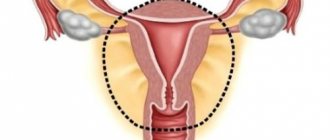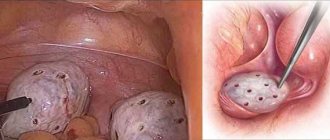Quite often, when diagnosing diseases, as well as to monitor the effectiveness of treatment, doctors prescribe a blood test to determine the level of tumor markers. In gynecology, one of these tumor markers is CA 125.
Exceeding the norm for the tumor marker CA 125 may indicate the development of endometriosis. This disease is the third most common among women of reproductive age. This marker, in conjunction with HE 4, is used in the verification of ovarian tumors.
Endometriosis is said to occur when endometrial cells, normally localized in the inner layer of the uterus, are found in other tissues and organs. In this case, irritation and inflammation of tissues occurs, and persistent pain syndrome develops due to changes in endometrioid cells according to the phases of the cycle.
Endometriosis can have two main forms, which are classified depending on the organ affected by the disease.
- Genital, characterized by the spread of endometrioid cells in the form of foci to the organs of the reproductive system. In the genital form, lesions are found in the uterus, vagina, cervix, ovaries, and tubes.
- The extragenital variety of the disease is the involvement of the lungs, intestines, conjunctiva of the eyes, and bladder in the pathological process.
Among all types of endometriosis, the leading one is adenomyosis, which means damage to the uterus. If left untreated, endometriotic lesions spread to neighboring organs and tissues.
The exact causes of endometriosis are unknown. There are about seventeen different hypotheses, the authors of which consider the possible reasons for the appearance of endometrioid cells in various organs.
Among the most likely causes of endometriosis, scientists identify:
- retrograde or reverse reflux of menstrual blood into the peritoneum;
- changes in hormonal status;
- immune disorders;
- metaplasia or the transformation of some body tissues into endometrial cells;
- intrauterine anomalies leading to the formation of endometrioid elements in various organs;
- surgical interventions that cause tissue trauma and subsequent spread of endometrial cells into neighboring tissues.
The clinical picture of endometriosis is characterized by a variety of manifestations. In some cases, the patient is examined by several specialists, and endometriosis is discovered by exclusion.
In general, you can suspect the presence of endometriosis based on the following symptoms:
- chronic pelvic pain, increasing during menstrual periods;
- shortening the cycle;
- heavy menstruation, beginning and ending with spotting;
- bleeding;
- infertility and miscarriage.
The appearance of symptoms of endometriosis is associated with bleeding of the lesions and the subsequent inflammatory process. In some forms of endometriosis, the formation of cysts and adhesions is observed, which prevent pregnancy.
Signs of endometriosis depend on the specific type. For example, if the lungs are damaged during menstruation, a woman experiences hemoptysis.
Often, women are in no hurry to visit a doctor, believing that painful periods are the norm. Gynecologists note that pain during menstruation is not the norm. Moreover, pain during menstruation is the main manifestation of endometriosis of any kind. Pain during menstruation should normally be tolerable and not require pain relief.
Importance of tumor marker
When cancer cells appear in the human body, their waste products, consisting of antigens, proteins, enzymes and hormones, begin to be produced in the blood. These same products are called tumor markers.
The Ca-125 marker is localized in the ovaries. Its level changes in the presence of cancer cells, as well as due to other pathologies, knowledge of which will help eliminate causeless anxiety.
An analysis that allows you to determine the substances of the oncological process in a woman’s blood helps to choose the right treatment and monitor the body’s response to it. But the marker is not the main criterion in diagnosing the disease.
To identify a woman’s diseases, the following markers are used:
- CA-125 is a specific antigen that increases in diseases of the female genital organs;
- CA-153 is a marker whose concentration increases in the blood with pathologies of the mammary glands;
- CEA, which stands for carcinoembryonic antigen. Varies depending on the type of malignant tumor;
- CA-199, which determines gastrointestinal pathologies.
The first tumor marker is prescribed in case of suspected pathological processes in the ovaries, mammary glands and uterus. Sometimes it is prescribed as a screening when mass medical examinations are carried out. In the case of a one-time increase in tumor markers, it is too early to talk about oncopathology. When tested for CA-125, elevated levels may indicate endometriosis or menstruation at the time of examination.
Why does CA-125 increase in endometriosis?
Endometriosis is one of the main reasons for elevated tumor markers. It is this pathology that is most often detected during a targeted examination. CA-125 may begin to rise before the first symptoms of the disease appear. Sometimes there are no changes on ultrasound yet, but the marker is already increasing.
It is not known for certain why the rate of this tumor marker increases in endometriosis. Several theories have been put forward:
- The phenomenon of micromenstruation. Endometriotic lesions are a collection of cells similar to the cells of the mucous layer of the uterus. They are sensitive to the influence of sex hormones and transform monthly. At the end of the next cycle they increase in size, at the beginning of the next they bleed. With the bloodstream, specific proteins are carried throughout the body, and CA-125 increases;
- Chronic inflammatory process. Micromenstruation leads to tissue damage. Blood in closed cavities does not find a way out, and the inflammatory process is activated. An increase in tumor markers is observed with any inflammation, regardless of the location of the process.
An increase in tumor marker is observed in endometriosis of any localization:
- Internal endometriosis (adenomyosis) – damage to the uterus;
- External endometriosis - the process involves the ovaries, fallopian tubes, peritoneum, vagina;
- Extragenital endometriosis - lesions are detected outside the reproductive organs: intestines, bladder, skin.
Foci of endometriosis spread.
In endometriosis, CA-125 rarely increases more than twice. Usually its level remains at the upper limit of normal or reaches 40-50 U/ml. The concentration of the marker does not depend on the localization of the process. There is evidence that the marker increases more often in endometrioid ovarian cysts and adenomyosis, but there is no reliable evidence of this.
Clinical trials have shown that CA-125 is more likely to increase with significant spread of the process and/or deep tissue damage. This often correlates with the severity of pain. The stronger the pain, the higher the tumor marker rises. But here it is important to remember: the pain threshold varies. Where one woman takes pills and cannot leave the house during menstruation, another leads a normal lifestyle and does without analgesics.
In what cases is the determination of CA-125 indicated?
If a woman has endometriosis, after carrying out all the necessary examinations, the doctor may prescribe a blood test for CA-125. As a rule, this is necessary in the case of:
- the presence of cysts on the ovaries;
- severity of endometriosis;
- uterine bleeding, which may cause endometrial pathologies;
- control over the treatment process and monitor dynamics;
- prognosis of relapse of endometriosis;
- exclusion of a malignant tumor, which in some cases is mistaken for a consequence of endometriosis.
The Ca-125 marker will help determine the presence of complications and the risk of cancer.
The norm is considered to be 8 units/ml. Indicators up to 35 units/ml, as a rule, indicate a pathology not related to the oncological process. Anything above this mark should raise red flags.
It is important to understand that each woman’s body is individual, therefore it is necessary to evaluate the analysis based on each specific case. In this case, it is necessary to take into account the phase of the cycle, age, and existing pathologies of the genital organs.
✅Instrumental diagnostic methods
We will consider existing diagnostic methods below.
Ultrasound is performed using the transvaginal method, during which a special sensor is inserted into the patient’s vagina, showing the condition of the uterine cavity. Ultrasound is prescribed without fail. The technique shows the degree of endometrial growth, changes in the size and shape of the uterus, and thickening of its walls, which indicates the formation of endometrial foci. Transvaginal ultrasound is prescribed in cases where there is a suspicion of a complication of endometriosis such as cysts on the ovaries. An ultrasound should be performed immediately after the end of menstruation, then the result will be as accurate and informative as possible.
Colposcopy is performed using a special sensor, a colposcope, inserted into the vagina. To obtain an accurate picture, determine the shape, size and localization of foci of the pathological process, contrast agents are used - iodine, acetic acid, Lugol. This method shows which soft structures of the genitourinary system have been affected by foci of endometriosis, and whether there are complications. Colposcopy is performed in cases where there is a suspicion of degeneration of foci of the pathological process into neoplasms of a malignant or benign nature.
Biopsy – performed after the end of menstruation to reduce blood circulation in the uterus. The essence of a biopsy is to take a piece of the endometrium and then examine it in the laboratory. The procedure is performed as follows: a thin tube with a piston is inserted into the uterine cavity through the vagina, through which a piece of the mucous layer of the uterus is separated. A biopsy is performed under local anesthesia.
Laparoscopy - this method of examination in gynecology is considered the “gold standard”; it allows you to obtain complete information about the stage and development of the disease. To perform laparoscopy, the patient's abdominal cavity is filled with carbon dioxide to create space between the internal organs. A puncture is made in the skin through which a laparoscope is inserted - a thin tube equipped at the end with a miniature camera that transmits the image to a monitor. Laparoscopy determines the color and shape of endometriosis foci, their size and distribution of soft structures.
Hysteroscopy - the procedure has two goals - diagnosis and treatment. It is carried out in the middle of the cycle. The abdominal cavity is filled with carbon dioxide, and a hysteroscope device is inserted through the vagina and uterine cervix into the organ cavity, showing changes in the structure of the uterus, the presence and prevalence of lesions.
CT and MRI are rarely used research methods. Indications for their implementation are the presence in a woman of signs indicating a worsening of the pathological process and total damage to the organs of the genitourinary system, in particular, the degeneration of endometrial lesions into oncological neoplasms.
Moderate to significant increase
Since the marker level often fluctuates, a slight increase is not a cause for concern. The most common reasons for increased CA-125 are:
- period of the menstrual cycle;
- inflammation of the female reproductive organs of a chronic nature;
- pregnancy;
- endometriosis;
- functional cysts on the ovaries;
- inflammatory pathologies in the pancreas and liver;
- allergic reaction.
In each specific case, the doctor must determine the exact cause of the marker increase and, if necessary, prescribe additional examinations.
A blood test exceeding 35 units/ml should alert the doctor and become a prerequisite for identifying the following diseases:
- malignant tumor of the ovaries or uterus;
- oncopathology of the gastrointestinal tract (liver, pancreas, rectum, stomach);
- mammary cancer;
- malignant tumor of the lungs.
Particular attention should be paid to increased rates in women who are premenopausal. When menstruation ends, elevated CA-125 levels require immediate consultation with an oncologist.
✅Laboratory research
Tests for endometriosis are aimed at identifying the stage of development of the disease and determining possible complications. To carry out a laboratory analysis, you need to donate blood on an empty stomach.
What tests are performed:
- tumor marker study;
- for hormones.
In case of endometriosis, hormone tests are necessary in order to identify the cause of the development of the pathology and select effective drug treatment.
Endometriosis is a hormone-dependent disease. Its development is influenced by the female hormone estrogen. If its level in the blood exceeds the normal level, oral contraceptives are prescribed to reduce the amount of estrogen so that the endometriosis lesions stop growing and begin to shrink. In the initial stages, drug hormonal therapy is enough for the disease to enter the stage of stable remission.
During a blood test, tests are taken for hormones, an increase or decrease in the concentration of which affects the development of endometriosis - prolactin, testosterone, progesterone. After donating blood, the doctor will need to analyze the data, on the basis of which therapy is prescribed.
A blood test to detect endometriosis includes the study of tumor markers and antibodies. Tumor markers are present in the body of every person, but their number is usually insignificant. If a person is sick, the concentration of these substances increases. Tumor marker CA 125 in endometriosis, the norm in women is exceeded, indicates the rapid development of the disease. Such an analysis is necessary in order to determine the risks of degeneration of endometriosis foci into malignant neoplasms.
The marker of endometriosis in the normal state of the reproductive system organs should not exceed 35 U/ml. If this figure is too high, a comprehensive diagnosis is prescribed. Its goal is to determine the initial stages of development of neoplasms in the ovaries, uterus, fallopian tubes and carry out their timely treatment, preventing further spread of the pathological process.
Decreased performance
Glycoprotein levels below normal indicate the effectiveness of the prescribed treatment method. If, after drug or surgical treatment, the level of CA-125 is consistently below normal, this indicates the onset of remission.
Endometriosis deservedly ranks among the dangerous diseases, since in most cases it causes infertility. Therefore, a blood test for CA-125 is a reliable assistant for the early detection of diseases, including cancer.
Inflammation of the appendages
Endometritis, salpingitis, adnexitis - inflammation of the endometrium, fallopian tubes - also increase the amount of CA 125. The causes of these ailments during menopause are different, but the root cause is weakening of the immune system due to a deficiency of female hormones, as well as drying out of the epithelium of the female organs and vagina, opening free entry inside various infections.
As we saw above, the quantitative indicator of carbohydrate antigen in the analysis may indicate inflammation of the serous membranes of various organs, causing the development of the following diseases:
- exudative pleurisy of the lungs;
- cardiac pericarditis;
- peritonitis;
- acute pancreatitis;
- liver cirrhosis;
- inflammation of the thyroid gland;
- hepatitis A;
- pneumonia;
- renal failure.
Features of the analysis
The analysis involves drawing blood from a vein, which is performed on an empty stomach. In addition, before donating blood for the CA-125 marker, the following measures are expected to be observed:
- 10 hours before the procedure, you must avoid eating any food;
- an hour before the test, refrain from smoking;
- this blood test must be performed in the first phase of the menstrual cycle;
- Before the procedure, you can only drink clean water; all other drinks can distort the results;
- Some foods may also cause incorrect test results. In this regard, it is recommended to abstain 3 days before the procedure from anything spicy, salty and fatty;
- Some medications may also distort the results, so before using any medications on the eve of the test, it is important to consult a doctor;
- at least three days before the procedure, it is necessary to avoid sports and medical procedures (ultrasound, massage, etc.);
- It is important that on the eve of the analysis the patient is in emotional balance.
Tumor marker values may be affected by parallel diagnostic procedures. Treatment of cancer involves conducting a CA-125 test every 3 months.
Study Information
marker CA 125 is of great importance in the diagnosis and treatment of ovarian cancer.
.
The analysis is based on detecting elevated levels of antigens in the blood - specific substances that indicate the occurrence of a tumor. These substances include some enzymes, hormones, proteins, protein products of tumor breakdown, etc. One of the most convenient markers for detecting ovarian cancer
at an early stage is CA 125. A blood test for the presence of antigen, carried out in a timely manner for preventive purposes, can help in early diagnosis of tumor.
In addition, this is a truly indicative tumor marker: specific CA 125 makes it possible to detect metastases six months
before their clinical manifestation. This in turn helps to evaluate the effectiveness of therapy in treating the disease. Control determination of CA 125 is recommended after treatment of endometriosis at intervals of 1-2 times a year. It is more informative to take this test 2-3 days after menstruation.
Preventive analysis: tumor marker CA 125:
You should know that the tumor marker CA 125 is present in small quantities in the uterine mucosa, however, it still does not enter the general bloodstream.
A physiological increase in the concentration of this indicator is possible during pregnancy and menstruation.
In case of oncology (benign or malignant tumors), the indicator usually increases several times, and in case of inflammation, uterine fibroids, endometriosis, menstruation, endometritis, etc., the indicator increases by several units.
Analysis for the tumor marker CA 125 is used to diagnose cancer, monitor the effectiveness of treatment and predict the course of the disease. Based on the results of the study, a diagnosis of cancer is not made.
No special preparation is required for the study. It is necessary to follow the general rules for preparing for research. It is more informative to take this test 2-3 days after menstruation.
GENERAL RULES FOR PREPARATION FOR RESEARCH:
1. For most studies, it is recommended to donate blood in the morning, from 8 to 11 o’clock, on an empty stomach (at least 8 hours must pass between the last meal and blood collection, you can drink water as usual), on the eve of the study, a light dinner with a restriction eating fatty foods. For tests for infections and emergency studies, it is acceptable to donate blood 4-6 hours after the last meal.
2. ATTENTION! Special preparation rules for a number of tests: strictly on an empty stomach, after a 12-14 hour fast, you should donate blood for gastrin-17, lipid profile (total cholesterol, HDL cholesterol, LDL cholesterol, VLDL cholesterol, triglycerides, lipoprotein (a), apolipo-protene A1, apolipoprotein B); The glucose tolerance test is performed in the morning on an empty stomach after 12-16 hours of fasting.
3. On the eve of the study (within 24 hours), avoid alcohol, intense physical activity, and taking medications (in consultation with your doctor).
4. 1-2 hours before donating blood, refrain from smoking, do not drink juice, tea, coffee, you can drink still water. Avoid physical stress (running, quickly climbing stairs), emotional excitement. It is recommended to rest and calm down 15 minutes before donating blood.
5. You should not donate blood for laboratory testing immediately after physiotherapeutic procedures, instrumental examination, X-ray and ultrasound examinations, massage and other medical procedures.
6. When monitoring laboratory parameters over time, it is recommended to conduct repeated tests under the same conditions - in the same laboratory, donate blood at the same time of day, etc.
7. Blood for research must be donated before starting to take medications or no earlier than 10–14 days after they are discontinued. To assess the control of the effectiveness of treatment with any drugs, a study should be conducted 7-14 days after the last dose of the drug.
If you are taking medications, be sure to notify your doctor.











